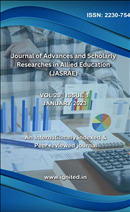Development of Novel Drug Delivery Systems for Enhancing the Bioavailability of Poorly Soluble Drugs
DOI:
https://doi.org/10.29070/whqd0t85Keywords:
Bioavailability, Solubilization, chemical modifications, Novel Drug Delivery Systems, SolubilityAbstract
One of the most effective ways to solve issues with medication bioavailability is via the use of novel drug delivery systems (NDDS). It refers to how quickly and to what degree a medicine reaches its intended target following delivery. Since only a tiny percentage of the dose actually makes it into the bloodstream and reaches the intended target, most modern medications have low bioavailability and need greater dosages. A large quantity of medication is wasted and unwanted side effects occur as a consequence of this. The primary goal of pharmaceutical technology is to increase the bioavailability of medications by making them more soluble and permeable. The idea behind NDDS is nanotechnology, which allows for the decrease in medication particle weight while simultaneously increasing stability and enhancing functioning. This review looks at the many methods for increasing bioavailability and the pros and cons of each.
References
Rashid, Mamunur & Malik, Yaseen & Singh, Sandeep & Chaturvedi, Swati & Gayen, Jiaur & Wahajuddin, Muhammad. (2019). Bioavailability Enhancement of Poorly Soluble Drugs: The Holy Grail in Pharma Industry. Current Pharmaceutical Design. 25. 10.2174/1381612825666190130110653.
Dey, Sanjay & Jha, Sajal & Malakar, Jadupati & Gangopadhyay, Dr. (2012). Improvement of Bioavailability of Poorly Soluble Drugs through Self Emulsifying Drug Delivery System. Journal of Pharma SciTech 2012; 1(2): 6-11. 1. 6-11.
Gowthami, Buduru & Krishna, S.V. & Rao, D. (2020). Novel Approaches to Enhance Oral Bioavailability of Poorly Soluble Drugs. International Journal of Research in Pharmaceutical Sciences and Technology. 2. 12-16. 10.33974/ijrpst.v2i1.231.
Mehta, Abhinav & Jain, Neha & Grobler, Anne & Bharti, Vandana. (2016). Role of Novel Drug Delivery Systems in Bioavailability Enhancement: At A Glance. International Journal of Drug Delivery Technology. 6. 7-26. 10.25258/ijddt.v6i1.8884.
Sushmitha, A. & Balaji, A. & UmaShankar, M.S. (2013). Strategies for enhancing oral bioavailability of poorly soluble drugs. Journal of Global Pharma Technology. 5. 1-10.
Zhang, L.; Hayes, D.G.; Chen, G.; Zhong, Q. Transparent Dispersions of Milk-Fat-Based Nanostructured Lipid Carriers for Delivery of β-Carotene. J. Agric. Food Chem. 2013, 61, 9435–9443.
Mehmood, T.; Ahmad, A.; Ahmed, A.; Ahmed, Z. Optimization of olive oil-based O/W nanoemulsions prepared through ultrasonic homogenization: A response surface methodology approach. Food Chem. 2017, 229, 790–796. https://doi.org/10.1016/j.foodchem.2017.03.023.
Koutelidakis, A.E.; Argyri, K.; Sevastou, Z.; Lamprinaki, D.; Panagopoulou, E.; Paximada, E.; Sali, A.; Papalazarou, V.; Mallouchos, A.; Evageliou, V. Bioactivity of epigallocatechin gallate nanoemulsions evaluated in mice model. J. Med. Food 2017, 20, 923–931. https://doi.org/10.1089/jmf.2016.0160.
Rodríguez-Burneo, N.; Busquets, M.A.; Estelrich, J. Magnetic nanoemulsions: Comparison between nanoemulsions formed by ultrasonication and by spontaneous emulsification. Nanomaterials 2017, 7, 190. https://doi.org/10.3390/nano7070190











